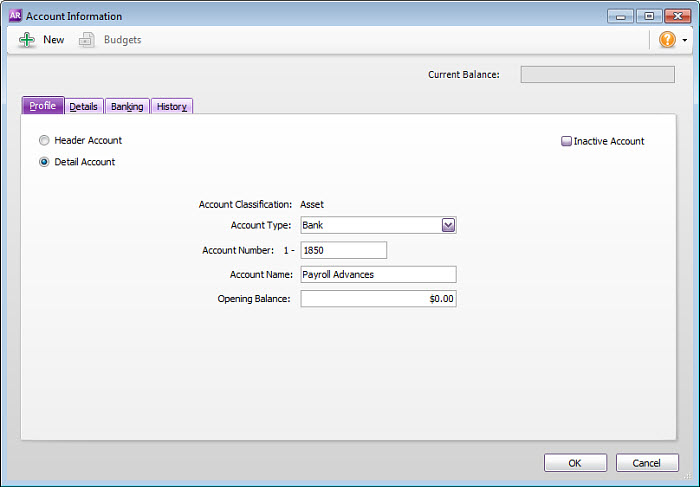You are viewing an old version of this page. View the current version.
Compare with Current View Page History
« Previous Version 5 Next »
https://help.myob.com/wiki/x/1o2O
How satisfied are you with our online help?*
Just these help pages, not phone support or the product itself
Why did you give this rating?
Anything else you want to tell us about the help?
This topic explains how to pay an employee a wage advance then withhold this amount from a future pay.
This is done by using a wage category to pay the advance, and a deduction category to repay the advance. Both these payroll categories are linked to an asset account which tracks all amounts advanced, repaid, and outstanding.
Let's take you through the details.
To track wage advances, set up the following:
- an asset account
- a payroll wages category
- a payroll deductions category
- Create an asset account with the Account Type set to Bank. This account will be used to keep track of how much you have advanced, and how much is repaid.

- Create a wages category. This category will allow you to include the advance on the employee's pay.
- Select Salary for the Type of Wages.
- Select Optional Account and choose the asset account created above.
- Click Employee and select the employee who is being paid the advance.
- In our example we'll click Exempt and select the PAYG Withholdings category so the advance is tax-free.

- Create a deductions category. This category will allow you to withhold the advance from the employee's future pay.
- Select the asset account created above for the Linked Payable Account.
- Set the Calculation Basis to User-Entered Amount per Pay Period.
- Click Employee and select the employee who is being paid the advance.

When you process your payroll, enter the amount being advanced against the Advance in Pay wages category.

If you exempted the wages category from PAYG Withholding, the addition of the advance won't affect the amount of tax withheld.
When you process your payroll, enter the amount being repaid against the Advance Repayment deductions category as a negative value.

FAQs
Run the Payroll Activity Detail report for employees who have been paid wage advances (Reports > Index to Reports > Payroll > Employees > Activity Summary).
- The value of the Advanced in Pay wage category will show how much has been paid in advance.
- The value of the Advance Repayment deduction category shows how much has been repaid.
The Advance Repayment deduction will be considered a liability so it'll show on the Pay Liabilities window awaiting payment. To remove this, complete a normal pay liability transaction, but in the Pay from Account field, select the Payroll Advances asset account. This will remove the amount from the Pay Liabilities window without affecting your account balances.

 Yes
Yes
 No
No
 Thanks for your feedback.
Thanks for your feedback.